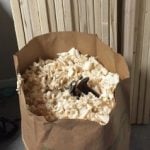Stanley #50 Combination Plane
Welcome! / Forums / General Woodworking Discussions / Tools and Tool Maintenance/Restoration / Stanley #50 Combination Plane
- This topic has 2 replies, 3 voices, and was last updated 7 years, 4 months ago by
YrHenSaer.
-
AuthorPosts
-

First of all, Merry Christmas to me! Finally was able to score a plough plane on eBay after chasing auction after auction or passing up on others because they were frequently missing a part here or there, no cutters, no depth gauge, missing screws, etc. This one came with a pretty full set of cutters and I even got the seller to throw in a 3/16″ iron (which unbeknownst to me is too small to even work in this plane! I just assumed they went all the way down to 1/8″ by default. Shows what happens when you assume!).
It came in reasonably good shape with most of the restoration work needing to be done to the cutters themselves–a lot of pitting and rust. One thing I found curious–I thought a diluted mix of white vinegar and water was supposed to be a good rust remover? I gave the whole set an overnight soak and then rubbed down with super-fine steel wool but as soon as I dried it off it started to oxidize/brown almost immediately so I found myself rubbing it down with 3:1 oil or WD-40 just to give it a protective coat. Is there anything I can do differently/better to restore/preserve the metal?
I’ve never used a plough before but think I’ll finally tackle the clock project in the near future. Any pointers? The iron in this plane seems to not always hold its depth and gets pushed back up by the wood–maybe I have it set too deep? I think later models have a lever and the cutters have notches–perhaps to overcome this issue?
Btw, what is the curved cutter used for? I assume the forked one is for tongue/groove type stuff? Now the hard part is going to be letting my wife wrap it up and have to wait for 2 weeks to use it after putting in all of the work to clean everything up!
Before:
[attachment file=143162]
[attachment file=143163]
After (I did a lot more work on the cutters than the plane itself…and did not photograph them).
[attachment file=143164]
[attachment file=143165]
Attachments:
You must be logged in to view attached files.
Vinegar is a mild acetic acid…. obviously. When used on iron as a rust remover, it helps to neutralise its after-effects with an alkali…. soda will do.
It looks as if your plane is an earlier model. That plane went through a number of later design iterations before production was abandoned. Originally, the cutter set went down to about 1/4″; the 3/16 and 1/8 blades were added later but it meant that they would not fit between the two stocks, (the combined depths of the two side grooves were wider than the blades) so, when using the two smaller blades, the moving stock was removed and a bolt with a large round head was substituted to clamp the blade sides.
Later planes incorporated a side lever for adjustment which engaged with serrations on the undersides of the blades.
You can read more on Patrick Leach’s site:
http://www.supertool.com/StanleyBG/stan7.htm
About half way down the page. There’s a pictue of the clamp for narrow blades, plus the chip deflector that nobody ever used…..Yes, the notched blade is for T&G. The groove is cut with (I think) the 1/4″ cutter. To test it for width, it should be just marginally wider than the gap in the tongue blade. If it fits inside, your T&G won’t slide together.
Good luck
-
AuthorPosts
- You must be logged in to reply to this topic.
